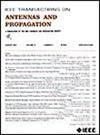基于SD-HMSIW技术的小型蛙形自双工MIMO天线
IF 5.8
1区 计算机科学
Q1 ENGINEERING, ELECTRICAL & ELECTRONIC
引用次数: 0
摘要
该通信提出了一种紧凑、低轮廓、双频屏蔽半模基片集成波导(SD-HMSIW)的自双工多输入多输出(MIMO)天线(SDMA),专为无线局域网(WLAN)应用而设计。MIMO配置包括两个垂直定位的相同自双工天线(SDA)元件,形成类似青蛙解剖结构的插槽配置。每个SDA元件在SD-HMSIW腔体的顶部导电表面上具有两个独特形状的修改槽。这些sda由独立的50- $\Omega $微带馈线驱动,促进5.2和5.8 GHz的辐射,端口之间具有良好的隔离性。所提出的SDA设计方法具有出色的通用性,能够在两个不同的频段独立工作。SDA元件的整体MIMO配置实现了紧凑的天线尺寸$0.40~\lambda {_{\text {g}}}^{2}$,端口之间的隔离度大于21 dB,在两个相同频率下谐振的端口增益为5.26和4.94 dBi。MIMO天线特性的结果包括包络相关系数(ECC)、有效分集增益(EDG)和复用效率(MUX),并对所提出的基于sd - hmsiw的SDMA进行了评估,结果令人满意。本文章由计算机程序翻译,如有差异,请以英文原文为准。
A Compact Frog-Shaped Self-Diplexed MIMO Antenna With SD-HMSIW Technique for WLAN Applications
This communication presents a compact, low-profile, dual-band shielded half-mode substrate integrated waveguide (SD-HMSIW)-based self-diplexed multiple-input multiple-output (MIMO) antenna (SDMA) designed for wireless local area network (WLAN) applications. The MIMO configuration comprises two orthogonally positioned, identical self-diplexing antenna (SDA) elements, forming a slot configuration resembling the anatomy of a frog. Each SDA element features two uniquely shaped modified slots on the top conducting surface of the SD-HMSIW cavity. These SDAs are driven by separate 50- $\Omega $ microstrip feed lines, facilitating radiation at 5.2 and 5.8 GHz with good isolation between the ports. The proposed SDA design method offers exceptional versatility, enabling independent operation at two distinct frequency bands. The overall MIMO configuration of the SDA element enables a compact antenna size of $0.40~\lambda {_{\text {g}}}^{2}$ , with isolation greater than 21 dB between ports and gains of 5.26 and 4.94 dBi at ports resonating at two identical frequencies. The outcomes of MIMO antenna features involving envelope correlation coefficient (ECC), effective diversity gain (EDG), and multiplexing efficiency (MUX) have been evaluated and found to be satisfactory for the proposed SD-HMSIW-based SDMA.
求助全文
通过发布文献求助,成功后即可免费获取论文全文。
去求助
来源期刊
CiteScore
10.40
自引率
28.10%
发文量
968
审稿时长
4.7 months
期刊介绍:
IEEE Transactions on Antennas and Propagation includes theoretical and experimental advances in antennas, including design and development, and in the propagation of electromagnetic waves, including scattering, diffraction, and interaction with continuous media; and applications pertaining to antennas and propagation, such as remote sensing, applied optics, and millimeter and submillimeter wave techniques

 求助内容:
求助内容: 应助结果提醒方式:
应助结果提醒方式:


